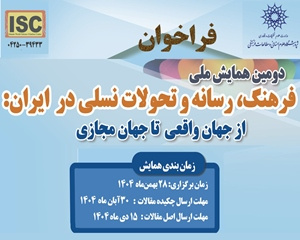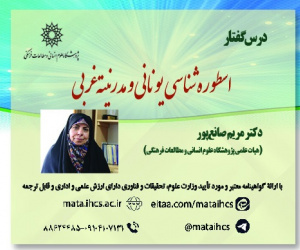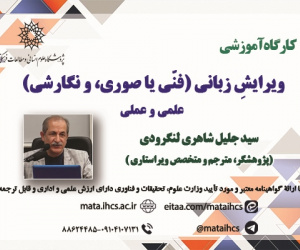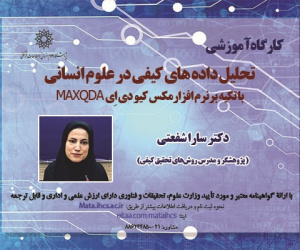مطالعه تطبیقی ساختار نقش مایه دهان اژدری در دو اثر تذهیب مکتب ترکمان ایران و دوره معاصر افغانستان (مقاله علمی وزارت علوم)
درجه علمی: نشریه علمی (وزارت علوم)
آرشیو
چکیده
هنر تذهیب از قدیمی ترین هنرهای رایج کشورهای اسلامی است. این هنر به عنوان یکی از تاثیرگذارترین هنرهای ایران و افغانستان مطرح است. در این پژوهش، دو اثر مورد تطبیق و مطالعه قرار می گیرد. اثر اول، متعلق به دوره شیوه تبریز مکتب ترکمان و اثر دوم، متعلق به دوره معاصر افغانستان است که نقش مایه دهان اژدری در این دو اثر مورد مطالعه قرار می گیرد. علت انتخاب موضوع وجود نقش مایه دهان اژدری به صورت مشترک در دو دوره مورد بحث با ساختار و قابلیت های متفاوت است که تاثیرپذیری از مکتب ترکمان را بر هنر تذهیب معاصر افغانستان نشان می دهد. هدف از این پژوهش، مطالعه نقش مایه دهان اژدری به عنوان یک نقش اصلی و تاثیرگذار در تذهیب است که دارای پیشینه طولانی است و تذهیب افغانستان در دوره معاصر از پیشینه فرهنگی دوره های گذشته تاثیر پذیرفته است؛ بنابراین، در این پژوهش پرسش اصلی این است که، ویژگی های نقش مایه دهان اژدری تذهیب شیوه تبریز مکتب ترکمان و دوره معاصر افغانستان کدام است؟ خصوصیات نقش مایه دهان اژدری در تذهیب هر دو دوره دارای چه شباهت و تفاوت هایی است؟ روش پژوهش فوق به صورت مطالعه تطبیقی و از نوع پژوهش کیفی بوده و جمع آوری اطلاعات به شیوه اسنادی (کتابخانه ای) است. در انتهای پژوهش نتیجه گرفته می شود، نقش مایه دهان اژدری از نقش مایه های اصیل ایرانی با قدمت طولانی بوده و از غنای نقش برخوردار است. تذهیب شیوه تذهیب مکتب ترکمان در زمینه نقش مایه دهان اژدری دارای نوآوری و خلاقیت بوده و تذهیب افغانستان در دوره معاصر با شناخت و آگاهی از تزیینات مشابه درزمینه پهنای ساقه، نیم دایره های مارپیچ و پیچ های فرعی در تز یینات تذهیب خود به ز یبایی بهره برده است."A Comparative Study on the Structure of the Dahan Azhdari Motif in two Gilded Works of the Turkmen Painting School of Iran and the Contemporary Period of Afghanistan"
The art of gilding is one of the oldest common arts in Islamic countries. This art is considered one of the most influential arts in Iran and Afghanistan. Two works are adapted and studied in this research. The first work belongs to the period of Tabriz's painting style and the Turkoman school, and the second work belongs to the contemporary period of Afghanistan. The reason for choosing the topic is the existence of the “Dahan Azhdari” pattern in the two discussed periods with different structures and capabilities, which shows the influence of the Turkmen school on the contemporary art of Afghan gilding. The main problem of this research is to study the role of “Dahan Azhdari” as a main and influential role in gilding having a long history, and the gilding of Afghanistan in the contemporary period. Tabriz school and the Turkmen style are considered independent styles from other periods of gilding art in Iran; according to the works of this period, the general features of the Ilkhanid period are as follows: the space between the lines in the gilding is filled with gold color; the variety of colors has increased and the rich colors of this school are influenced by Iranian art and green and blue colors are dominant; much precision is used in the designs, which is the result of the influence of Chinese painting.Through the Turkoman school’s gilding method, the gilding in the contemporary period of Afghanistan has become wider in terms of decoration, and there are open and closed texts different from the composition of the works of previous periods, and it is no longer limited by the analogy of the previous periods. Variation in decorations and types of overall form of gilding components is one of the other characteristics of contemporary Afghan gilding works. So in some works of gilding, even two similar components cannot be found in decorations and petals. The studied work of the Turkmen school gilding method in the present study is the gilded Badragh page from the book of Islamic arts. This work was in 1478. It was dedicated to Sultan Khalil, the eldest son of Uzvan Hassan, the ruler of Agh Quyunlu - who ruled for six months in Tabriz. The dimensions of this work are 120.3 x 13.5 cm, with ink, gold, and matte watercolor on paper. The main form of this work is bergamot in the center of the work. Around the bergamot, there is a closed text in the form of an analogy. After the closed text, two borders are engraved around it, and in the last part of the border, the porch is located on three sides of the border. There is a text in the center of Toranj, “Wa Al-Dhain Abul-Fath Sultan Khalil Bahadur Khaldullah Malika wa Sultana wa Afaz Ali Al-Alamin Yare wa Ehsana” in Nastaliq script, which indicates that this work was commissioned for Sultan Khalil. The most used colors in the work are azure, gold, black, and brown. The second studied work from the contemporary period of Afghanistan is Badragh page by Mohammad Yunus Jami. Mohammad Yunus Jami, calligrapher and gilder of contemporary Afghanistan in 1990 AD. He was born in the city of Herat. His father, who was a scholar and art lover, seeing his son's talent, sent him to the art workshop of master Abdul Jalil Tawana to benefit from the master's knowledge in 2003. This period can be considered as the sound that not only awakened Jami's artistic taste but also excited his soul. By entering the Faculty of Fine Arts of Herat University in 2009 he reached a new approach to art and was particularly influenced by the teachings of master Abdul Naser Swabi. At the end of this course, he made an effort to study and examine the tombstones of the Timurid period. It was as a result of these studies that he got special artistic inspiration. He took the works of the Timurid period as a model for his artistic works. Even though Jami has a taste for deconstruction, he is a follower of the Herat school. As can be seen in the works of the Tabriz style of the Turkmen school, some of the characteristics of the Herat school with a different language have been inherited. At the same time, the artist has created a special style in this area, which has increased its functionality and efficiency with the use of new designs, considering the originality of the traditional foundations. The work of the Badragh page of the contemporary period of Afghanistan, 27 x 42 cm, is made with gold color and handmade Ahar Mahreh Indian paper by Jalil Jokar. In the center of the lower side of the tangerine work in a rectangular frame, it has the overall shape of an altar and there is an inscription in the upper part of it. A border has been worked around these two central roles, and there is a border on the last three sides. The work mostly uses azure, gold, brown, and black colors, and red and turquoise colors are also used in some of its partial decorations. Below is the examination and application of the “Dahan Azhdari” pattern in a step-by-step manner, firstly, the spiral stem, then the general form of the pattern, and finally, its decorations.Research question The main question here is: what are the characteristics of the motif of “Dahan Azhdari” gilding in the Tabriz school and the Turkoman style, and the contemporary period of Afghanistan? What are the similarities and differences between the characteristics of the “Dahan Azhdari” motif in the gilding of both periods?Research MethodologyThe method of this research is of a qualitative type and it was carried out by a comparative method, and collecting information through a documentary (library) method. The sampling of the statistical population of the current research is a case study of two works: one from Tabriz school and the Turkmen style, and the second from the contemporary period of Afghanistan, where the application of the “Dahan Azhdari” motif in the gilding of the two works is discussed. The selection of both samples has been done according to their general similarities with other works of the same period.FindingsIn the results of this research, the estimation of the similar features of “Dahan Azhdari” motifs in the gilding of the Tabriz school and the Turkoman style and the contemporary period of Afghanistan is discussed, which shows the importance of these features due to its continuation in the contemporary period. Distinctive features of Afghanistan's contemporary style, which is considered a kind of innovation, are expressed. In response to the question of the similarities between the motif of the “Dahan Azhdari” in the Tabriz school of the Turkmen style and Afghanistan, it can be acknowledged that: the type of spiral on which the “Dahan Azhdari” is formed in both works is of the Archimedean type. The position of the “Dahan Azhdari” on the Archimedes spiral in both works is placed at the beginning, middle, and end of the spirals in the last three semicircles. In both works, there are three types of motifs: semi-symmetrical, asymmetric, and half motifs. In all three types, the arrangement and location of the repetition and rhythm in the decorations are the same due to the Turkmen style of Tabriz school, and Afghan schools. In the decorations of both works, there are three decorations similar to the curved tooth and band. There is no distinction in the general form of the tooth and curved in both works and it is completely similar to each other. In the section of the stanza, the placement of the stanza at the end of the motif in both works can be mentioned as a commonality. In response to the differences between the motifs of the mouthpiece in the two works, it can be stated that in the contemporary work of Afghanistan, the stem of the Archimedean spiral is wider than in the work of the Turkoman style, and due to the proximity of the five and a half circles, which have less space, the distance between the spirals is also less. The maximum number of semicircles in the contemporary work of Afghanistan is six and in the work of Iran, it is four. The internal sub-spiral in the Afghan work is finer and smaller than the main spiral, but in the Iranian work, the width of both stems is the same. In all three types of semi-symmetric, asymmetric, and semi-" “Dahan Azhdari”, the width of the beginning of the motif in the contemporary work of Afghanistan is more than that of the Turkoman style, and with a rhythm that has a greater acceleration from the narrow to narrow in width, its length is more than the work of the Turkoman style. In the part of tooth decorations in the contemporary Afghan work compared to the the Turkoman work, the overall shape of the “Dahan Azhdari” is smaller and it resembles a part of the curve; Because it is placed at the beginning of the decoration of the curve. The maximum number of curves in the contemporary Afghan work reaches nine; But in Iran, there are five, and the decorative form of the band is relatively independent and separate from the form of the motif in the Iranian work. In the Afghan work, the end of the spiral in the form of a band is placed at the beginning of the motif as a decoration.








